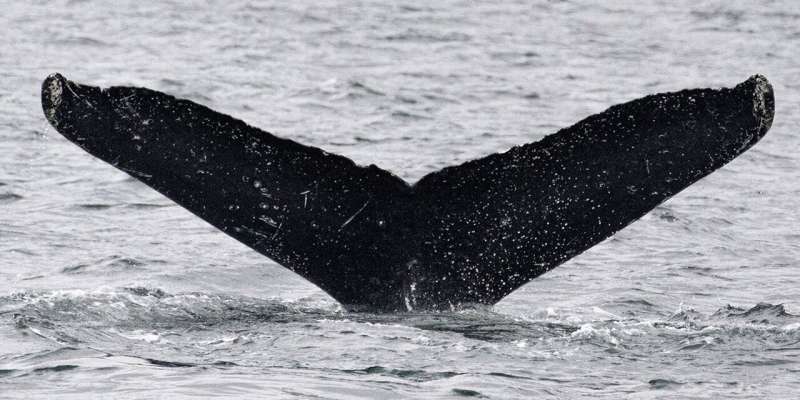This article has been reviewed according to Science X's editorial process and policies. Editors have highlighted the following attributes while ensuring the content's credibility:
fact-checked
peer-reviewed publication
trusted source
proofread
Encounter with humpback whales reveals potential for nonhuman intelligence communication

A team of scientists from the SETI Institute, University of California Davis and the Alaska Whale Foundation, had a close encounter with a non-human (aquatic) intelligence. The Whale-SETI team has been studying humpback whale communication systems in an effort to develop intelligence filters for the search for extraterrestrial intelligence.
In response to a recorded humpback "contact" call played into the sea via an underwater speaker, a humpback whale named Twain approached and circled the team's boat while responding in a conversational style to the whale's "greeting signal." During the 20-minute exchange, Twain responded to each playback call and matched the interval variations between each signal.
A description and analysis of the encounter appears in a recent issue of the journalPeerJ, titled "Interactive Bioacoustic Playback as a Tool for Detecting and Exploring Nonhuman Intelligence: 'Conversing' with an Alaskan Humpback Whale."
"We believe this is the first such communicative exchange between humans and humpback whales in the humpback 'language,'" said lead author Dr. Brenda McCowan of U.C. Davis.
"Humpback whales are extremely intelligent, have complex social systems, make tools—nets out of bubbles to catch fish, and communicate extensively with both songs and social calls," said co-author Dr. Fred Sharpe of the Alaska Whale Foundation.
"Because of current limitations on technology, an important assumption of the search for extraterrestrial intelligence is that extraterrestrials will be interested in making contact and so target human receivers. This important assumption is certainly supported by the behavior of humpback whales," said Dr. Laurance Doyle of the SETI Institute, a co-author of the paper.
Similar to studying Antarctica as a proxy for Mars, the Whale-SETI team is studying intelligent, terrestrial, non-human communication systems to develop filters to apply to any extraterrestrial signals received. The mathematics of information theory to quantify communicative complexity—(for example rule structure embedded in a received message) will be utilized.
Other team members and co-authors of the paper are Dr. Josie Hubbard, Lisa Walker, and Jodi Frediani, with specialties in animal intelligences, humpback whale song analysis, and photography and behavior of humpback whales, respectively. A second paper by the team will soon be available on the non-audio communicative behavior of humpback whales—bubble rings made in the presence of (and possibly for) humans.
More information: Brenda McCowan et al, Interactive bioacoustic playback as a tool for detecting and exploring nonhuman intelligence: "conversing" with an Alaskan humpback whale, PeerJ (2023). DOI: 10.7717/peerj.16349
Journal information: PeerJ
Provided by SETI Institute




















